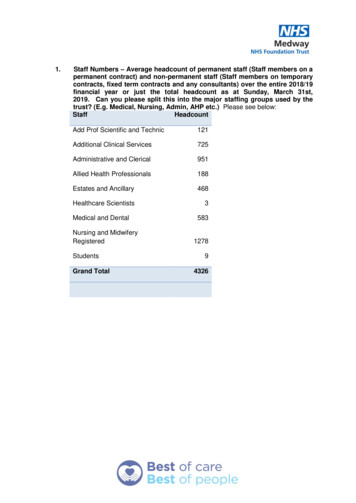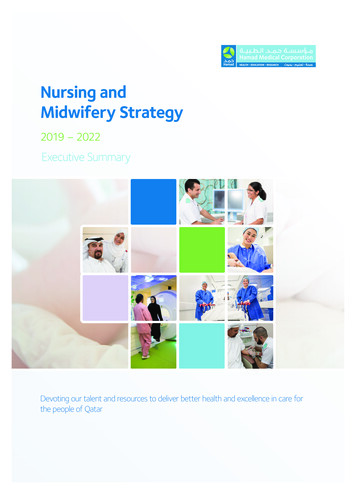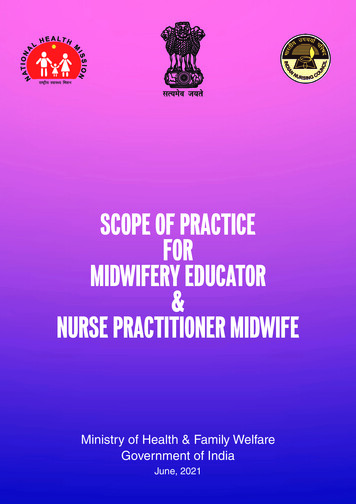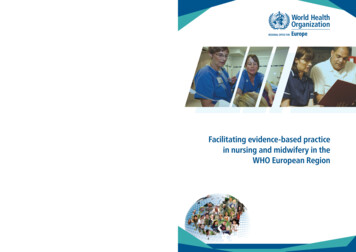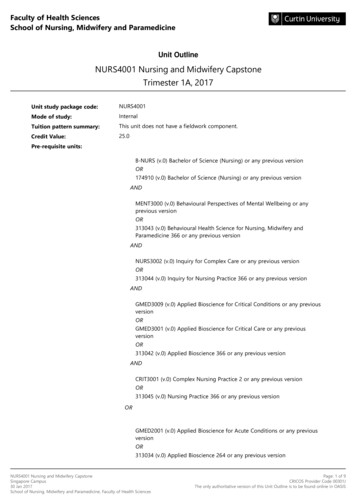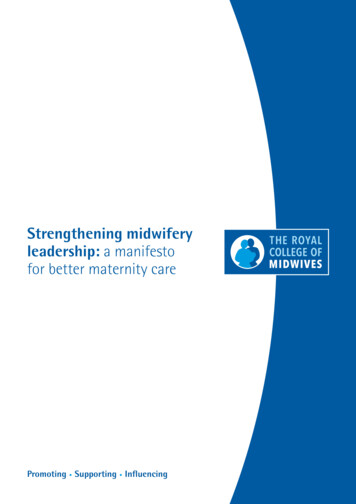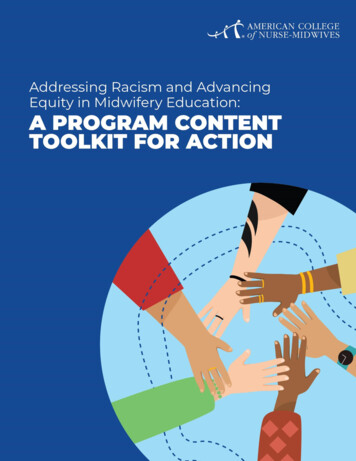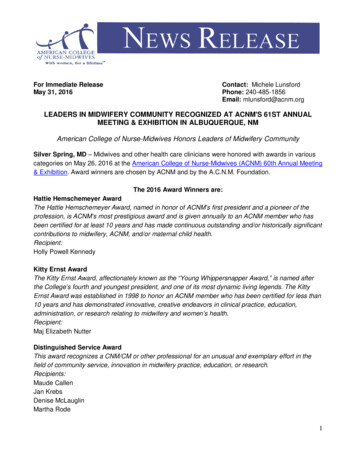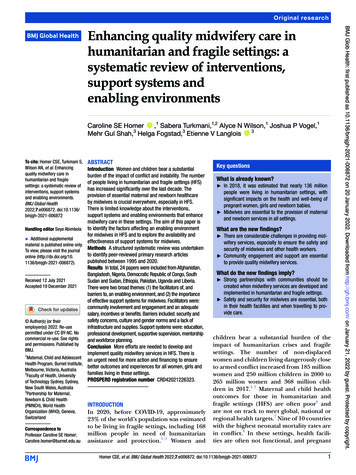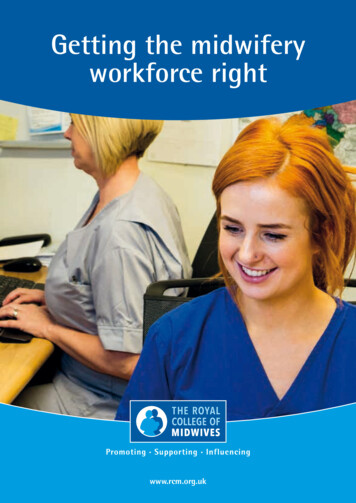
Transcription
Getting the midwiferyworkforce rightwww.rcm.org.uk
Getting the midwifery workforce rightKey messages The role of the midwife is clearly described and demarcated. The evidence shows thatit is in the interests of women to receive the majority of their care from a small groupof midwives they know and trust. Midwifery services should be staffed to enable thisto happen. The role of the midwife has developed over the years to meet changing populationneeds and in a changing context of healthcare delivery. The role of the midwife canencompass new tasks but this should always be a) in the interests of women and theirbabies b) properly resourced c) supported by defined competencies and appropriateeducation and d) within their scope of practice. When a midwife takes on new tasks this does not equate to taking on a specialist oradvanced role. A midwife may focus her skills on a specific group of women e.g. teenage mothers,women with drug or alcohol problems, safeguarding etc. This does not make her aspecialist or advanced midwife. A specialist midwife would be expected to play a morestrategic role in service delivery. A specialist midwife would be expected to receivereferrals from other midwives or GPs when care was particularly complex. She wouldalso be expected to network amongst other services, have a role in policy influencingand setting for that service and a key role in education. Specific local circumstances primarily related to size of service and rural services mayexceptionally mean it is appropriate for a midwife to undertake tasks which in anothercontext are usually performed by other professionals e.g. scrubbing in theatre orundertaking ventouse deliveries. Support workers play a vital part in maternity teams. They may be employed in clerical,housekeeping or care giving roles. MSWs in particular make an important contribution.There should be a nationally agreed framework with competencies for such rolessupported by national training programmes. There is no need for a nurse associate role in maternity services. Consultant midwives have clearly defined roles, make an enormous difference to theclinical leadership and practice development within units as well as being the catalystsfor change and improvement.1 The Royal College of Midwiveswww.rcm.org.uk 2
Getting the midwifery workforce rightIntroductionRole of the midwifeMaternity services like the rest of the NHS are facing severe financial challenges. The paradox foreveryone involved in funding, managing and delivering maternity services is how on the one hand:The role of the midwife is to ensure that women receive the care they need throughout pregnancy,childbirth and the postnatal period. Much of this care will be provided directly by the midwife,whose expertise lies in the care of women and babies during normal birth and pregnancy. Whereobstetric or other medical involvement is necessary, the midwife continues to be responsiblefor providing holistic support, maximising continuity of carer and promoting a positive birthexperience for the woman.“The NHS could and should raise its game on personalised support to parents and their babies,better team working, better use of technology and more joined up maternity services” (SimonStevens, CEO NHS England)But on the other hand:“cuts in staffing and reduction in quality are inevitable if the government’s priority is to restorethe NHS to financial balance” (Kings’ Fund 2016)In order to try to bring some clarity into debates, policies and decisions about how maternityservices should be configured, funded and staffed, the RCM has developed this guidance whichexplains the role of the midwife, the limits and scope of the role, its relationship with otherprofessionals and care givers and the approaches which are most likely to lead to safe and effectivestaffing decisions.The way in which the role of the midwife evolves and develops over time may have significantimplications for the overall focus and quality of midwifery care, on the best use of resources andon the midwifery profession itself. That is why the RCM has developed this guidance for midwives,MSWs, other members of the maternity team, midwifery service providers and policy makers.Definition of the roleThe formal definition of a midwife that has been adopted by the International Confederation ofMidwives (ICM), the International Federation of Gynaecologists and Obstetricians (FIGO) and theWHO reads as follows:“A midwife is a person who, having been regularly admitted to a midwifery educationalprogramme, duly recognised in the country in which it is located, has successfully completedthe prescribed course of studies in midwifery and has acquired the requisite qualifications to beregistered and/or legally licensed to practise midwifery.She must be able to give the necessary supervision, care and advice to women during pregnancy,labour and the postpartum period, to conduct deliveries on her own responsibility and to care forthe newborn and the infant. This care includes preventative measures, the detection of abnormalconditions in mother and child, the procurement of medical assistance and the executionof emergency measures in the absence of medical help. She has an important task in healthcounselling and education, not only for the women, but also within the family and the community.The work should involve antenatal education and preparation for parenthood and extends tocertain areas of gynaecology, family planning and child care. She may practise in hospitals, clinics,health units, domiciliary conditions or in any other service.”3 The Royal College of Midwiveswww.rcm.org.uk 4
Getting the midwifery workforce rightThe activities of a midwife are defined in the European Union Midwives Directive 80/155/EECArticle 4 as follows:Thinking about midwifery in 2016“Member states shall ensure that midwives are at least entitled to take up and pursue thefollowing activities:The role of the midwife as primary carer for women and infants experiencing normal pregnancyand birth has remained essentially unchanged for many years. The value of this role lies inmidwives’ extensive knowledge, expertise and their ability to detect and act appropriately on awide range of clinical and other indicators in pregnancy, labour and the postnatal period. to provide sound family planning information and advice to diagnose pregnancies and monitor normal pregnancies; to carry out examinationsnecessary for the monitoring of the development of normal pregnancies to prescribe or advise on the examinations necessary for the earliest possible diagnosis ofpregnancies at risk to provide a programme of parenthood preparation and a complete preparation forchildbirth including advice on hygiene and nutrition to care for and assist the mother during labour and to monitor the condition of the foetusin utero by the appropriate clinical and technical means to conduct spontaneous deliveries including where required an episiotomy and in urgentcases a breech delivery to recognise the warning signs of abnormality in the mother or infant which necessitatereferral to a doctor and to assist the latter where appropriate; to take the necessaryemergency measures in the doctor’s absence, in particular the manual removal of theplacenta, possibly followed by a manual examination of the uterus to examine and care for the newborn infant; to take all initiatives which are necessary incase of need and to carry out where necessary immediate resuscitation to care for and monitor the progress of the mother in the postnatal period and to giveall necessary advice to the mother on infant care to enable her to ensure the optimumprogress of the newborn infant to carry out the treatment prescribed by a doctor to maintain all necessary records.”Midwifery is very much relationship-focused rather than providing task or intervention based care.It has its biggest impact on outcomes where midwives are able to provide consistent care over thecontinuum of antenatal, intrapartum and postnatal care. The intention of delivering continuity ofcarer i.e. of each pregnant woman seeing as few different health care staff as possible, is centralto policy for maternity services across the UK. This is not because midwives are territorial abouttheir role but because they play a distinct role in caring for women and because of the wealthof evidence that shows continuity of care provided by a midwife is linked to the best clinicaloutcomes for women. Any discussion about the maternity workforce therefore needs to start froma clear understanding that the shared primary objective must be to have sufficient staff withsufficient skills/competence/expertise, to minimise the number of different contacts a woman willbe required to have during her pregnancy, birth and early postnatal period.The RCM affirms the ICM/FIGO/WHO definition of the role of the midwife and the definitioncontained in the European Union Midwives’ Directive. However, whilst the role of the midwifeand her scope of practice are established in statute, there is considerable pressure due tocurrent policy initiatives and the changing context of service delivery for flexibility in the focusand emphasis of that role. The current emphasis on developing a ‘flexible’ NHS workforce, areexacerbating these challenges.For many years the legal definition of a midwife has been accepted by the regulators, the NHS andthe profession itself, to encompass the care provided during pregnancy and the postnatal period.Practically this means that for the majority of women midwives make autonomous decisionswithout reference to a medical practitioner throughout the pregnancy continuum and take fullresponsibility for their decision making. Where necessary the midwife has a responsibility to referwomen to appropriate professionals but to continue to provide care.5 The Royal College of Midwiveswww.rcm.org.uk 6
Getting the midwifery workforce rightAccordingly, the RCM recognises that: local and national policy, strategy, population and staffing needs all legitimately shape thefocus and emphasis of a midwife’s daily work; the provision of safe, effective and high quality care requires a reasonable degree offlexibility on the part of staff groups and careful consideration of an appropriate skill mixfor different maternity settings; midwives should acknowledge that even when they are the sole care giver, if women are toget safe care they must work within multi-disciplinary teams; and midwives are able to access opportunities to develop and enhance their skills and interests.This means that any work to review the skill mix in maternity must be focused on ensuring thatwomen still receive care that is holistic as opposed to task orientated. Other staff can and shouldnormally be employed in support roles if this leads to greater efficiency, and appropriately educatedstaff may undertake delegated roles again if this does not undermine the basic principle of womenreceiving the bulk of their care from an appropriately qualified professional they know and trust.In order to achieve this it is important to sustain a clear definition of the role of the midwife, inorder to ensure consistency in standards of care and the continued advancement of a definedmidwifery body of knowledge.The RCM welcomes any development of the midwife’s role which enhances these skills andexpertise, or which makes midwifery care more accessible and responsive to women’s needs. Inthe context of ensuring that women are able to exercise choice about the care they receive it iscritically important to ensure that there are midwives in the workforce who are competent to: work in different settings and to address particular needs which impact on maternal andinfant wellbeing (for example domestic violence, substance misuse, homelessness); and work in new ways and partnerships to meet the range of women’s needs to, for example,promote seamless care or reduce unnecessary delays or barriers such as distances inaccessing care and to learn new skills.Midwives have, however, proved adaptable in responding to changes in the context of their role,and in the settings and systems within which midwifery care is provided. In recent years midwiveshave become used to and grown in confidence in sharing some elements of care to maximisetheir productivity.7 The Royal College of Midwiveswww.rcm.org.uk 8
Getting the midwifery workforce rightMidwives already take the lead in making decisions with women about the nature of their careand planning as well as providing ‘hands-on’ care, as well as co-ordinating care with otherspecialist colleagues.Currently there are a number of developments that have the potential to impact on the role andscope of practice of midwives. These include: National policy drivers to enhance the role of the midwife, such as Better Births the reportof the national maternity review in England, the Strategic Vision for Maternity Services inWales, the Strategy for Maternity Care in Northern Ireland and the forthcoming review ofmaternity services in Scotland. An increasing focus on the public health role of the midwife and the opportunity todeliver broader public health interventions as part of maternity care which expands thecomponents of routine midwifery care1. Strategies for role development across different staff groups, from senior consultants, tomidwives, nurses and allied health professionals through to support workers. These anticipatea more flexible approach to professional roles and skill mix, a more developed contributionto prevention, public health and family wellbeing services as well as an increased presencewithin integrated services, multi-disciplinary teams and cross-sectoral partnerships. Changes to junior doctors’ roles and responsibilities and to their working hours. The continued development of the role of Maternity Support Workers (MSWs). Opportunities for midwives to develop clinical skills, such as ultrasonography and theexamination of the newborn. Changes in the birthrate and in the demographic profile of childbearing women, such asdecreases in teenage pregnancies, increases in births to women aged 40 and older and thegrowing proportion of pregnant women who have pre-existing medical or social conditions.These have implications for rates of caesarean sections and other interventions, which cansignificantly alter the content of midwifery work. Midwifery and other staffing shortages. All of the above happening in a broader context of an NHS experiencing extreme financialchallenge where safety, productivity, financial balance, choice for women and staff healthand wellbeing all have to be addressed.These developments will require different responses, ranging from simple adaptations andchanging emphasis within the role as normally practised, to incorporating new or additionalskills into the role e.g. examination of the newborn, to the development of specialist rolesfocusing on particular issues e.g. mental health, and finally to developing leadership roles e.g.consultant midwives.The RCM welcomes the fact that midwives are developing areas of interest and specialist skills, andaffirms that this is an important part of providing a service response to the increasingly diverseneeds of all communities within the population. It will be most effective where midwives sustaintheir competency and confidence in core midwifery practice. It is important that specialist skillsare not automatically conflated with ‘higher’ skills; and that professional development, gradingand other rewards and opportunities do not assume that specialisation equals expertise of ahigher value than core midwifery. A midwife who simply concentrates her midwifery expertise ona particular segment of the population is no different from a midwife who has a general caseload.However if a midwife not only focuses her skills on a specific group of women e.g. women withmental health problems but also provides a focus of referral from other midwives, has a role indeveloping policies and guidelines for this group, educates other midwives etc. she may fit acategory of practice which may be described as ‘advanced’ and may be rewarded differently. Therole of the specialist perinatal mental health midwife, for which the RCM has developed specificcompetencies, would come into this category.The RCM accepts that the boundary between midwifery skills and medical skills is not inflexible,and that some midwives may develop particular skills in order to sustain continuity of carer,allow more women to benefit from midwifery care at home or in midwifery units or otherwise toimprove the care available to women and their babies. Good examples of this are perineal repair,cannulation, examination of the newborn and undertaking the six-week postnatal examination.However this is about adapting the midwife’s role to accommodate women’s requirements; it is notabout advancing skills.The RCM does not however endorse the extension of the midwife’s role into obstetric, nursingor other spheres of practice where this does not demonstrably improve the quality of, or accessto, midwifery expertise. Whilst the RCM accepts that NHS organisations wish to maximisethe flexibility of their workforce, it is not acceptable to permanently alter midwifery roles tocompensate for staffing shortages or changes in doctors’ roles (for example, by routinely requiringmidwives to assist in caesarean sections).1 The RCM’s public health model Stepping up to Public Health is of particular relevance in this context stepping-up-to-public-health9 The Royal College of Midwiveswww.rcm.org.uk 10
Getting the midwifery workforce rightWe do not believe that this kind of response solves the fundamental problem of medical shortagesbut merely moves the problem onto another profession2. Equally, while the RCM appreciates thatmany midwives may wish to acquire obstetric skills, this needs to be balanced with the value ofsustaining the midwifery model of care.Guiding criteria for the development of midwives’ roles should be considered across the wholeservice area, and should include: The impact on core midwifery care and associated standards (for example, the ability toprovide one-to-one care in labour). The availability of funds to adequately resource associated training, professionaldevelopment, monitoring and audit. Acceptability to midwives and to women.Service needs will vary in different localities and with different populations, and the rationale fordeveloping particular roles, or substituting roles traditionally undertaken by midwives with otherprofessionals, will vary accordingly. For example, it is probably more efficient and effective for theaverage sized consultant unit to use professionals other than midwives, such as scrub nurses, toassist in theatre. However in a very small obstetric unit it may still be more efficient and effectiveto use midwifery staff. Equally in an HDU a nurse may be better suited to provide general highdependency nursing care, working alongside a midwife who provides the midwifery care. Whereas,a rural midwifery unit may decide that training midwives in ventouse extraction would make avery real difference to the service’s ability to provide accessible, seamless care. In all cases, therationale for role development should be demonstrable (in terms of improved maternal and infanthealth outcomes) and not merely in terms of convenience or professional preference.Midwifery numbersThe RCM continues to maintain that England is 3500 midwives short based on the broadrequirements of Birthrate Plus. Even in Scotland, Wales and Northern Ireland, where there arebroadly enough midwives to meet demand, large numbers of skilled and experienced midwivesare due to retire in the next 5 to 10 years. The impact of the shortages in England is demonstratedby Heads of Midwifery who report routinely reducing services, and temporarily closing services aswell as reducing access to midwives’ training and development opportunities. We have evidencedthis in our State of Maternity Services Report3. The impact is also shown in the amount of unpaidadditional hours midwives are routinely working, their failure to take required breaks and thestress they are under. In terms of the impact on women, the RCM is fully supportive of the visionfor maternity services set out in the Better Births and we completely concur that this vision is notachievable without adequate staff and without the time and resources to develop, educate andlead these midwives. This is consistent with our assessment for maternity services across the UK.The RCM continues to support Birthrate Plus as a robust and credible workforce planning tool formidwives4. It has a long track record in enabling managers to measure the work and time involvedin providing high quality maternity services and translating this into staffing numbers. It hasnow been endorsed by NICE as a workforce planning tool that can assist with implementing therecommendations in the NICE guideline for safe midwifery staffing5.We are aware that BR requires updating so as to reflect current midwifery practice, such as thehuge workload associated with safeguarding and child protection, the increased role of midwivesin providing public health and the evidence of the Birthplace study in relation to the safety ofmidwifery-led care. We are keen to work with BR on a reissue of the methodology to ensure thatit continues to be relevant and helpful.We welcomed the publication of the NICE safe midwifery staffing guidelines and are currentlycompleting assisting guidance for Heads of Midwifery to ensure they are equipped to use it. Lastyear we issued an FOI request to gauge the extent to which NHS trusts are using the guidelines.At that point 42 per cent of trusts had still not used the guidelines to formally review midwiferystaffing, although half of these did have plans to do so.2 This begs many questions around accountability and governance if midwives take on more roles outside their scope of practice.11 The Royal College of Midwives3 RCM (2015) State of Maternity Services Report 2015 https://www.rcm.org.uk/briefings-and-reports4 The RCM is however aware that Scotland has developed its own tool based on the Association of UK University Hospitals (AUKUH)nursing care tool.5 rcm.org.uk 12
Getting the midwifery workforce rightEncouragingly, 33 per cent of trusts had used the guidelines and had identified a shortage ofmidwives, with 28 per cent reporting that their boards now had an agreed plan to increasestaffing levels.We hope to see future guidance reinforcing the requirement to use the guidelines.The RCM is pleased that student midwife commissions have increased slightly in recent years (ata time when student nurse commissions have generally reduced) and to some extent this hascontributed to a reduction in the midwifery shortage. However, from our own membership databasewe can see that the demographics of the profession are changing and that there will be largenumbers of skilled and experienced clinicians and leaders retiring within the next five years. We arenot convinced that the numbers entering the profession will continue to balance those predicted toleave and we are concerned that there will be a shortage of clinical and managerial leaders.Our overall conclusion therefore is that very often the shortage of midwives is not necessarilya supply issue, although the situation does vary across the UK. In England in particular, this isa problem of trust finances constraining the ability of maternity services to employ sufficientmidwives, leading to excessive workloads/caseloads, over use of agency staff and failure toproperly manage peaks of activity. For women this means that whilst most maternity services meetthe standard of 1:1 care in labour, antenatal care is often disjointed and the quality of postnatalcare poor, with insufficient specialist midwives to care for women with particular needs andconditions (such as recently highlighted shortages in maternal mental health) and it means thatunits close or services are withdrawn. For midwives it means a long hours culture, where there islittle support for continuing professional development and high anxiety caused by continuallyfeeling unable to give of your best. So the real challenge for the maternity workforce is that thereare not enough midwives and the real solution lies in recognising that if the NHS is serious aboutdelivering the care it aspires to, it has to increase the number of midwives it employs.13 The Royal College of Midwiveswww.rcm.org.uk 14
Getting the midwifery workforce rightMaternity skill mixMaternity Support Workers6The NHS currently faces enormous financial challenges, with real growth since 2010 virtuallyflatlining at 0.1 per cent a year and 67 per cent of English providers finishing 2015/16 in deficit. Itis these financial challenges that are driving the policy solutions and practical management actionsthat have been advanced in recent months. The RCM has successfully challenged individualorganisations that have proposed, among other things:The MSW role, a non-regulated, non-professional staff member able to provide support tomidwives, to take on some routine tasks and work under delegated authority has becomeincreasingly important since its widespread introduction twenty years ago. MSWs make animportant contribution to maternity care, and the development of that contribution shouldbe encouraged. The RCM supports the appropriate use of MSWs and have welcomed theminto membership. The RCM recommends that support workers should be integrated within thematernity care team, working under the supervision of midwives, and appropriately trained.They should not undertake duties which require midwifery training and registration, be theprimary named contact or lead professional, or be used to deputise for midwives. However, giventhe nature of midwifery care and the midwifery role, particularly the focus on minimising anypossibility of unnecessarily fragmenting care, there will always be a limit to the amount of careMSWs can undertake and the total number of MSWs that can be employed. engaging volunteers to do the work currently undertaken by MSWs; employing nurses to care for pregnant women undergoing induction of labour and inpatient antenatal care; requiring midwives to routinely undertake ventouse deliveries; using midwives to fill in for junior doctor vacancies on tier one rotas.The RCM wholly supports the concept of the right staff in the right place at the right time doingthe right thing. There is much work currently undertaken by midwives that could be better andmore appropriately carried out by administrative and clerical staff, by house keeping staff andmost obviously through a support role that allows units to flex their skill mix.We recognise that midwives are not the only carers that contribute to high quality maternity careand indeed that they are not always the most appropriate person – for example midwives shouldnot be routinely cleaning rooms, maintaining patient records or (as per our comments above)assisting in operating theatres.The legal definition of a midwife means that in practice, midwives can make autonomous decisionswithout reference to a medical practitioner throughout the pregnancy continuum and take fullresponsibility for their decision making. This is important in the context of governance around rolesubstitution or delegated decision making. In more recent years midwives have become used toand grown in confidence in sharing some elements of care with non-regulated health colleaguesin order to maximise their productivity. Midwives already take the lead in making decisions withwomen about the nature of their care and planning as well as providing ‘hands-on’ care. These arenot separate or distinct elements of maternity but central to midwifery.It is fair to say that for many midwives accepting this role has been a challenge and many initiallysaw this as role substitution. However, it is also fair to say that in the last 20 years MSWs haveproved time and time again their value to the wider maternity team and to women; they providecapacity and skills, they allow for a more flexible deployment of workforce and they allowmidwives to spend more time with women who need them most.Matching staffing levels, skill mix and staff deployment to the model of care, taking staff healthand wellbeing into account, is complex – and even more challenging when resources are restricted.The RCM is disappointed therefore that recent reviews, particularly the Cavendish Review of therole of support staff and the Carter Review of efficiencies in hospitals, have given insufficientattention to support functions in maternity services. This has either been ignored or it has beenassumed that a nursing model is automatically transferable to midwifery.What concerned midwives about the MSW role and continues to be the concern of the RCM is thewide variation in role, in training and development and in the pay and conditions of this group ofcolleagues. In England there is now a wide range of MSW job descriptions, titles and roles from6 The term ‘Maternity Support Worker’ is used to describe any unregistered employee who works specifically for a maternity serviceand who provides support to a maternity team and to women and their families. There are however other titles used in different partsof the UK for these employees, such as Maternity Care Assistants and Maternity Care Support Workers. This paper uses MaternitySupport Workers and MSWs as generic terms to cover all such posts.15 The Royal College of Midwiveswww.rcm.org.uk 16
Getting the midwifery workforce rightcleaning rooms after delivery, processing paperwork, data input, delivering health promotionmessages, providing practical p
7 The Royal College of Midwives Getting the midwifery workforce right www.rcm.org.uk 8 Accordingly, the RCM recognises that: local and national policy, strategy, population and staffing needs all legitimately shape the


